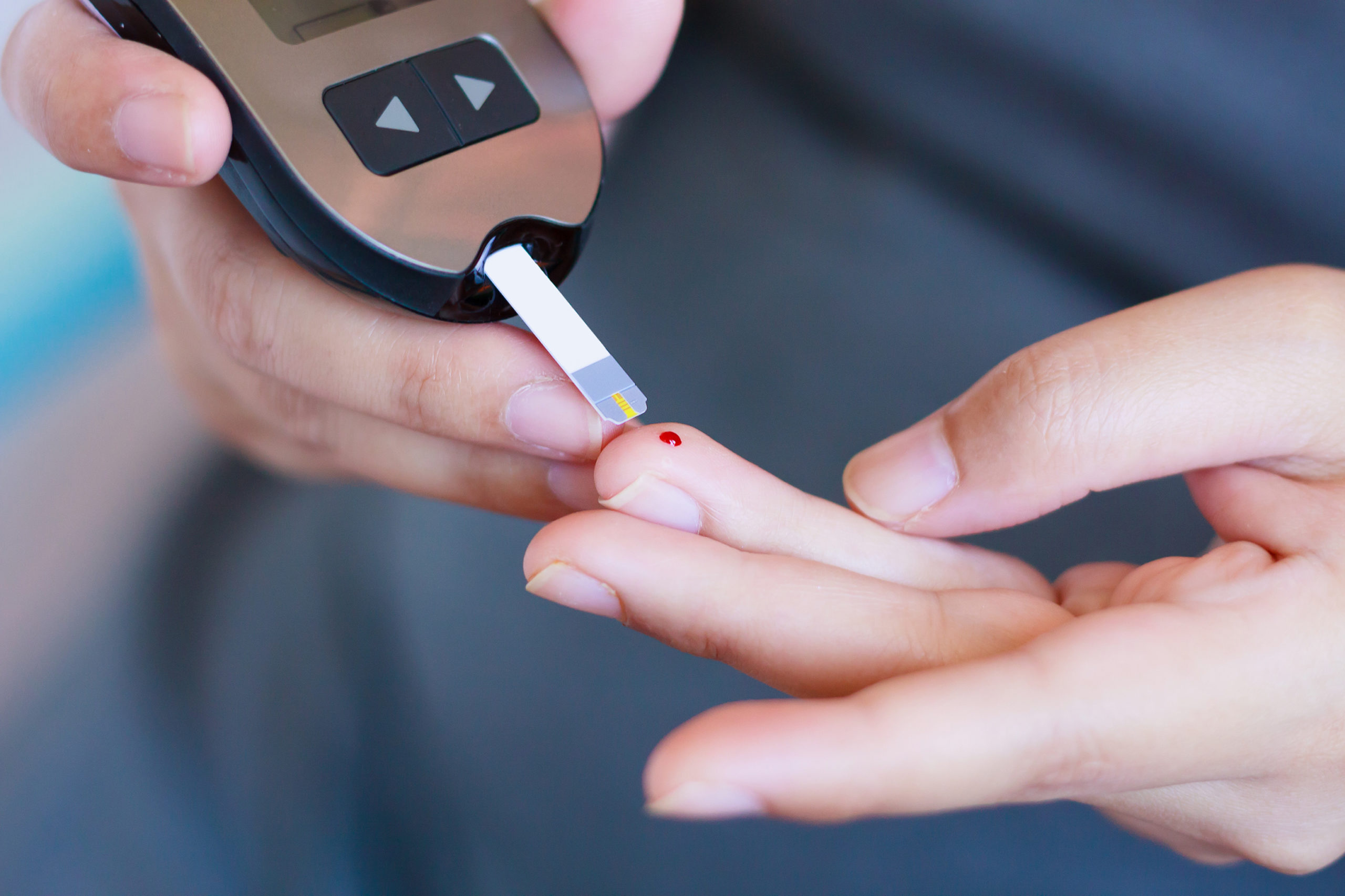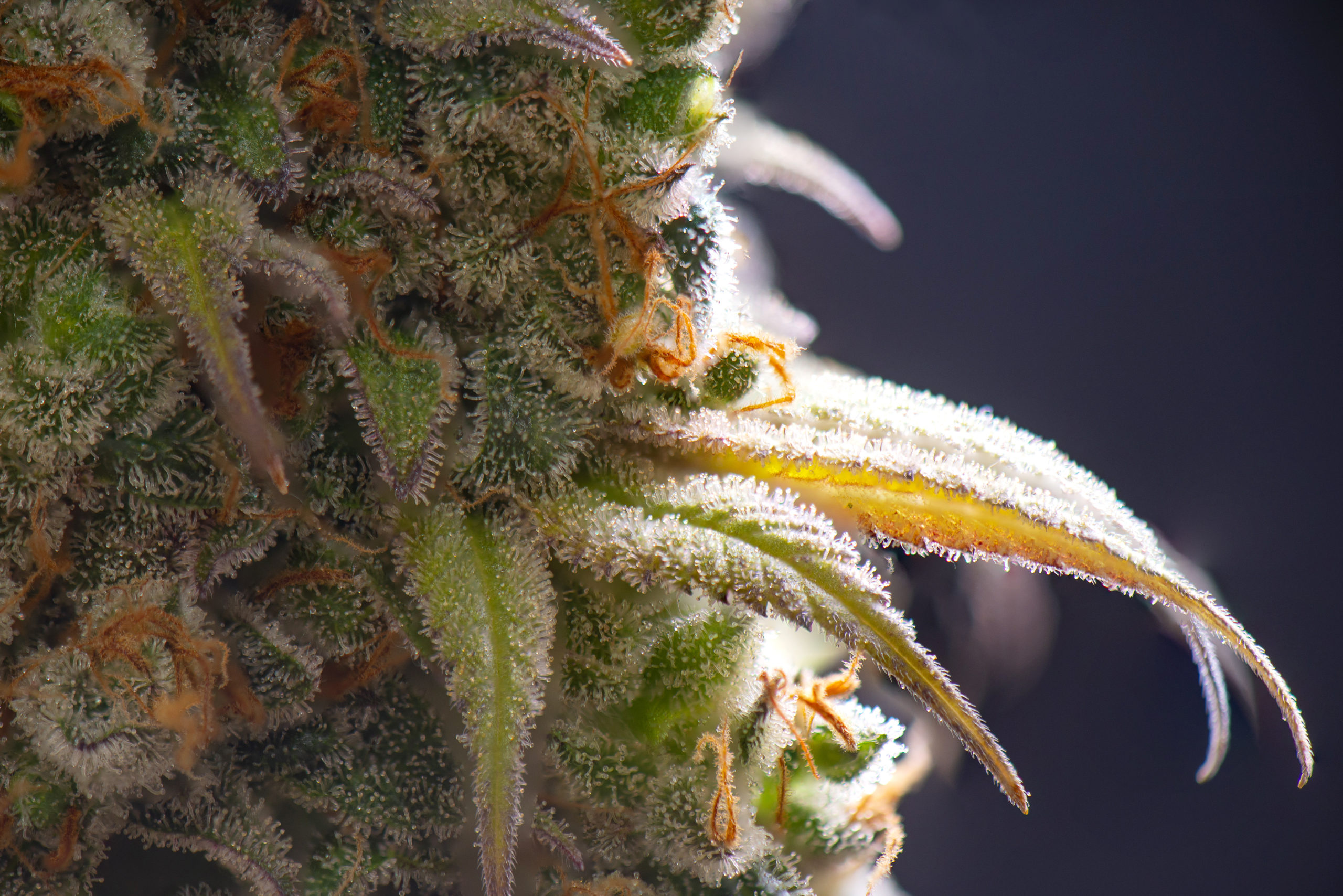-
- Market Research
- |
- CBD Near Me
- |
- Giveaways
- |
- Newsletter
- |
- Contact
- |
- Advertise
- |

In the absence of a cure, low-side-effect therapeutic agents like cannabidiol (CBD) are the next best thing for Parkinson’s Disease (PD) sufferers.
Research initiatives focused on the neuroprotective properties of this natural constituent of hemp and marijuana, while still underway, strongly suggest that CBD may have the potential to slow the progression of the disease.
This could mean improved mobility and independence for PD sufferers, even as the disease progresses into the middle and later stages.
What is Parkinson’s Disease?
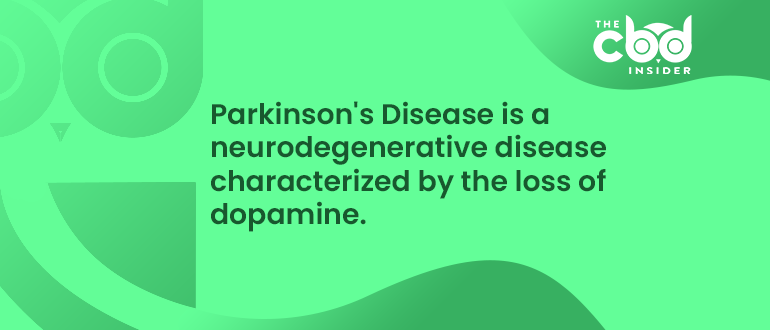
The neurons in our brains use chemical messengers called neurotransmitters to execute all kinds of functions, like preparing the brain and body for sleep, treating pain, reacting to hazards, and much more.
In the case of Parkinson’s, the neurons that produce dopamine in an area of the brain called the substantia nigra are adversely affected such that dopamine production is permanently deficient (hence PD’s classification as a “neurodegenerative” disease).
In addition to making us feel happy, as it is popularly understood, dopamine in this context (the basal ganglia) has a very important role in controlling voluntary movement, including initiation, maintenance, and cessation of everyday movements like walking.
Dopamine also regulates behaviors and emotions to a certain extent.
Because Parkinson’s Disease sufferers don’t have enough of this vital neurotransmitter, they struggle with voluntary movements, in addition to behavioral and emotional symptoms.
How Many People Are Affected by Parkinson’s Disease?
The Parkinson’s Foundation reports that 60,000 Americans are diagnosed with PD annually, and the total number of diagnosed people is approaching one million nationally and ten million globally.
Also of note is the disease’s affinity for men, who are affected at one and a half times the rate that women are.
Though researchers haven’t been able to find a cure, they use large-scale prevalence studies to determine who has the disease, where it is most concentrated, and how resources can be best distributed.
Decades of data collection and studies focused on the disease have also taught the scientific community about the many manifestations of Parkinson’s Disease.
Depending on the precise area of the brain affected and the progression of the disease, PD sufferers can experience an entire spectrum of symptoms beyond movement issues.
What Are the Signs and Symptoms of Parkinson’s Disease?
Symptoms of Parkinson’s progress slowly and incrementally, often taking years to advance from one stage to the next.
As mentioned, the variability of symptoms is largely credited to the area of the brain affected by PD, meaning the following issues may differ proportionally from person to person:
- Tremors
- Bradykinesia (slowness of movement, especially when initiating)
- Rigidity
- Dyskinesia (erratic writhing of face, arms, or legs)
- Shuffling gait
- REM sleep behavior disorder
- Hypophonia (speaking very quietly)
- Micrographia (small handwriting)
Signs of Parkinson’s Disease include difficulty sleeping, loss of smell, dizziness or fainting, and hunched posture.
The postural concern brings us to the issue of secondary problems associated with PD.
When progressed enough to restrict mobility to a wheelchair or a walker, PD can indirectly worsen tissue rigidity in weight-bearing joints important to healthy mobility, like the hips, knees, and vertebral joints.
Confinement to a wheelchair also invites skin integrity problems and general cardiovascular health decline.
Some of the signs and symptoms above occur as part of the normal aging process, which is why physicians pay close attention to the severity and frequency of the symptoms before officially diagnosing anyone with PD.
What Causes Parkinson’s Disease?
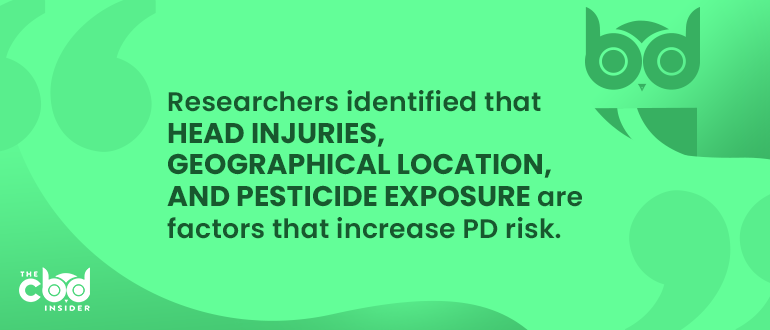
Epidemiologists are missing the most important piece of the puzzle when it comes to preventing and/or curing Parkinson’s Disease: causality.
While scientists may not be able to pinpoint the specific mechanism that causes Parkinson’s, they have managed to correlate a number of genetic and environmental risk factors with PD onset probability.
According to the Parkinson’s Foundation, PD sufferers often display a similar set of genetic mutations.
Environmental causes are not so concrete, but researchers have identified head injuries, geographical location, and pesticide exposure as factors that increase PD risk.
As of 2013, research by the Center for Neurodegenerative and Neuroimmunologic Diseases at Rutgers suggests oxidative stress (cell damage caused by a surplus of free radicals) may be a major contributing factor.
Though they’re a helpful start, these vaguely defined categories of risk don’t satisfy the question of causality to an extent that enables a standardized cure.
How Parkinson’s Disease Affects Your Brain
We’ve already covered the macro-level concepts as it regards how Parkinson’s works, but everyday consumers and researchers alike need to learn the underlying mechanisms involved in both a healthy and Parkinson’s-affected brain in order to appreciate how therapeutic agents like cannabidiol can help.
How Your Brain Is Supposed to Work
The billions of nerve cells in your brain (neurons) use cable-like extensions called axons to transmit impulses from one neuron to the next.
When an outgoing impulse or “message” reaches the end of an axon, it approaches a gap between the sending and receiving nerves known as the synapse.
The impulse is then ferried across the synapse by a specific chemical messenger, or neurotransmitter—dopamine in this instance.
Once the dopamine accomplishes its job of getting the impulse across the synapse to the receiving neuron, it is broken down by enzymes.
How Your Brain Works with Parkinson’s Disease
In the case of PD, the cells that produce dopamine die off for an unknown reason.
When the dopamine deficiency reaches 80 percent, the more readily recognizable symptoms of tremors and rigidity begin to manifest as communication between neurons is seriously impaired.
The immune system activates microglia in response to the rampant destruction of dopamine-producing cells; microglia are a type of immune cell that cause inflammation and further damage to neurons when overstimulated.
In addition to glial cell activation, this article by the National Institute on Aging highlights another hallmark of PD that is cryptically tied to a form of dementia: the formation and deposition (in the brain) of alpha-synuclein proteins.
These proteins can cause a form of dementia known as Lewy body dementia, another potentially debilitating neurodegenerative disease.
How does cannabidiol counteract these harmful developments, you might be wondering?
Through its interactions with the endocannabinoid system (ECS), CBD can help to recoup some of what was lost or support what still remains when it comes to the damage wrought by PD mechanisms.
The Endocannabinoid System in PD
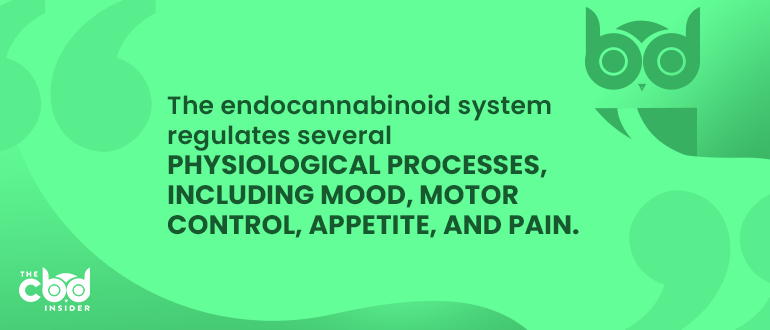
Our bodies already produce their own cannabinoids—anandamide is the chief example.
Since anandamide is “endogenous,” meaning humans already create it on their own, then it stands to reason that the body would have built-in receptors meant to interact with this cannabinoid, which it does.
Cannabidiol simply helps to stimulate what is already there, a set of two receptors (CB1 and CB2) known as the endocannabinoid system, in order to impart its health-affirming effects.
The endocannabinoid system regulates several vitally important physiological processes, including mood, motor control, appetite, and pain.
“Stimulating” is a potentially misleading word as it concerns the way in which endocannabinoids interact with this system, because they actually have a modulating effect, preventing excess excitation or inhibition.
For example, CBD can partially offset the effects of a THC high by changing the shape of the receptor that THC binds to so less of the intoxicating cannabinoid makes it through, a process known as non-competitive inhibition.
These endocannabinoid system receptors are found abundantly in the basal ganglia, which bears great importance in the treatment of PD symptoms.
It seems logically contradictory, but the endocannabinoid system is actually thought to be hyperactive in the case of PD, which is why ECS antagonists like cannabidiol may be helpful.
Thus, targeting the ECS to restore balance in the basal ganglia is a potential therapeutic target that can help PD sufferers throughout each stage of the disease.
Stages of Parkinson’s Disease
Parkinson’s is slow, progressive, and different for everyone.
Despite its broad variability in terms of presentation, each stage of the disease is characterized by one or more hallmark characteristics.
Stage 1
- Mild tremors may present, often affecting just one side of the body at first.
- Handwriting becomes smaller and less precise.
- Loss of smell.
- Sleeping difficulties.
Most patients who aren’t dealing with severe comorbidities or generally poor health will not experience mobility issues in stage one.
Stage 2
- One-sided tremors and rigidity may now affect both sides of the body.
- Tremors are still mild but may be more noticeable.
- Mobility may be moderately compromised.
Tremors in the upper extremities may become severe enough at this stage to make activities of daily living like tying shoes, washing dishes, and other chores more difficult.
Stage 3
- Bradykinesia
- Possible balance impairment; increased fall risk
- Lower tolerance for weight-bearing mobility and chores
- Forward-flexed posture becomes apparent
Some patients may have a walker at this stage, and they could have trouble initiating and stopping movements.
Stage 4
- Severe tremors, rigidity, and mobility impairments requiring a walker and/or wheelchair.
- Handwriting gets smaller and sloppier, and the patient’s speaking volume declines (hypophonia).
- Balance, fine and gross motor control, and reflexes all continue to decline.
With steady rehab, some patients in stage four can manage with a walker alone, but many will need a wheelchair.
In standing, the patient will present with moderate to severe forward-flexed posture, increasing difficulty with gait training because the walker will be pushed forward by the patient’s body weight before the legs can initiate movement.
The great majority of patients in this stage will need assistance to go about their daily lives.
Stage 5
- Patient is wheelchair-bound.
- Tremors continue to worsen, including dyskinesia or writhing movements.
- Severe bradykinesia (can take ten seconds or more to initiate movement if successful).
- Non-motor issues of sleep disturbances, behavioral changes, and psychotic symptoms become more pronounced.
Hopefully, the stage five patient stands up from their wheelchair several times a day for assisted exercises and/or grooming tasks, chores, etc., but some patients will find it extremely difficult and tiring, which in turn worsens their mobility even further.
This patient will undoubtedly require heavy assistance for the majority of their daily activities, like getting into and out of the chair, dressing, eating, and so forth.
How is Parkinson’s Treated?
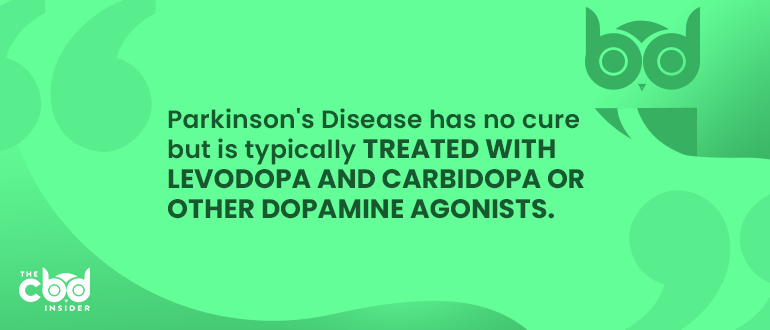
We’ve already established that there is no cure for PD at this junction, so current treatment protocols focus on supporting the brain’s dopamine level as much as possible.
Medication does this by inhibiting the enzymes that break down dopamine, inhibiting acetylcholine and glutamate (which impair dopamine uptake in this case), and substituting dopamine when possible.
To date, the gold standard in PD medication is levodopa.
Levodopa and Carbidopa
Chemically, levodopa mimics the compound that turns into dopamine.
After oral ingestion, the body converts this precursor into dopamine so that the brain can use it in the hopes of recouping as much of the vital neurotransmitter as possible.
A drug called carbidopa is commonly prescribed with levodopa because it prevents nausea and keeps the “pre-dopamine” agent that is levodopa from being converted to full-on dopamine before it gets to the brain.
Unfortunately, Levodopa can actually worsen the involuntary writhing movements referred to clinically as dyskinesia, which researchers have attributed to the rising and falling of dopamine levels associated with taking Levodopa pills (as opposed to a steady drip).
Dopamine Agonists
Simply put, agonists are compounds that bind to a receptor and stimulate that cell to perform its intended action.
Like Levodopa, these medications (Mirapex and Requip, for example) act as synthetic dopamine in an attempt to keep the dopamine receptors in the brain firing.
Long-term use of dopamine agonists has been linked to sleep disorders, nausea, vomiting, irregular heart rhythms, swelling, hallucinations, and uncontrolled movements.
Cannabidiol, on the other hand, continues to pass one wave of scrutiny after another when it comes to low-side-effect PD treatment.
Studies Show CBD Is Effective for Parkinson’s Disease
The findings below suggest that CBD may promote several vital processes relevant to the prevention and treatment of Parkinson’s Disease, such as:
- Antioxidant protection of neurons
- Sleep disorder treatment
- Psychosis treatment
- Overall quality of life improvements.
As mentioned, the endocannabinoid system is active in the area of the brain affected by Parkinson’s Disease, but CBD also interacts with outside receptors to address PD symptoms.
For example, University of Louisville researchers discovered that CBD acts as an inverse agonist at GPR 6 receptors (meaning it stimulates them to do the opposite of their normal function), which have been associated with dopamine reduction.
Through these mechanisms and others, CBD is showing promise as a viable treatment for PD symptoms.
Here’s what the research has to say.
Review of Cannabinoids in Basal Ganglia Disorders
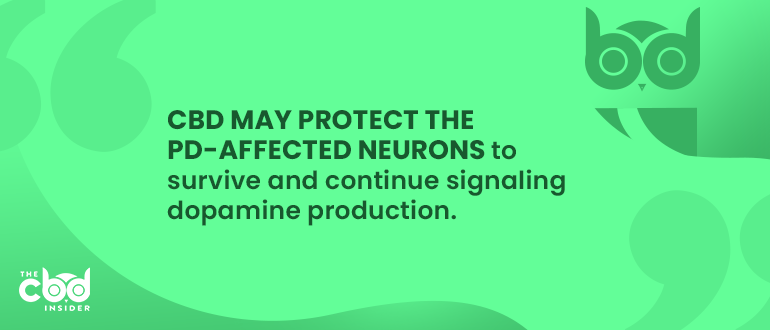
Department of Molecular Biology and Biochemistry researchers at Complutense University of Madrid, Spain found several applications for cannabidiol and other cannabinoids in the treatment of basal ganglia disorders.
For example, their review noted that “cannabinoids like Δ9-tetrahydrocannabinol or cannabidiol protect nigral or striatal neurons in experimental models of both disorders (PD and Huntington’s), in which oxidative injury is a prominent cytotoxic mechanism.”
In other words, the antioxidant power of CBD may be just the kind of protection that PD-affected neurons need to survive and continue signaling dopamine production.
Additionally, the review found that stimulation of CB2 receptors slows the degeneration of the nerves in both Parkinson’s disease and Huntington’s disease.
Finally, the anti-inflammatory effect of cannabidiol and other cannabinoids can combat the problem of microglial cell activation that we mentioned earlier, as these cells use inflammation to cause more nerve damage.
CBD and Rapid Eye Movement Sleep Behavior Disorder
Most of us are technically paralyzed during the deepest stage of sleep, known as rapid eye movement or REM sleep, but not Parkinson’s patients.
Unable to relax completely because of the disease, some PD patients actually “act out” their dreams, meaning they vocalize, move their extremities, and roll around in bed—this is REM sleep behavior disorder.
In a case series published in the Journal of Clinical Pharmacy and Therapeutics by a team of University of Sao Paulo and University of Minnesota Medical School researchers, CBD helped the four participants with RBD to significantly reduce or completely eliminate their RBD episodes without side effects.
Three of the participants were administered a dose of 75mg, and the fourth was administered 300mg.
Only the fourth patient had RBD episodes after treatment, and it only occurred once.
As to the mechanism involved, the researchers believed that CB1 activation is responsible for the drastic improvements in RBD symptoms, mainly because CB1 cells are prevalent in areas of the brain related to sleep.
CBD for Parkinson’s-Related Psychosis
A study conducted by Department of Neuropsychiatry and Medical Psychology faculty at the University of Sao Paulo found that CBD capsules significantly decreased psychotic symptoms in six PD patients versus a placebo.
The starting dose of 150mg a day was increased by 150mg on a weekly basis until the four-week period ended, during which time patients were assessed for psychotic symptoms using the Brief Psychiatric Rating Scale (BPRS).
Thanks to the thoroughness of this outcome measure, researchers were able to isolate the specific areas of psychological health that improved the most after CBD supplementation, like positive and negative thought patterns, sleep disturbances, hallucinations, and more.
The researchers theorized based on these results that the “rapid onset of the antipsychotic effect” of CBD in this case “may have occurred through the attenuation of dopaminergic activity in areas related to the production of psychotic symptoms.”
The dopaminergic activity in reference is caused by synthetic dopamine receptor agonists like the medications already mentioned, meaning that CBD can offset medication-induced psychosis without causing equally harmful effects in another department.
Clinical Trial Uses CBD as a Parkinson’s Disease Treatment
A study by Sao Paulo and Belo Horizonte (Brazil) University neuroscientists found that CBD improved quality of life for patients administered 300mg/day of the supplement.
The 21 participants were divided into three groups and given a placebo, 75mg/day of CBD, or 300mg/day of CBD before being assessed for motor function, quality of life, and neuroprotective effects using various scales.
Quality of life was the only statistically significant difference between placebo and experimental groups, but the researchers called for “studies with larger samples and specific objectives” to further investigate the possible links between CBD supplementation and motor function.
How Does CBD Help Parkinson’s Disease?
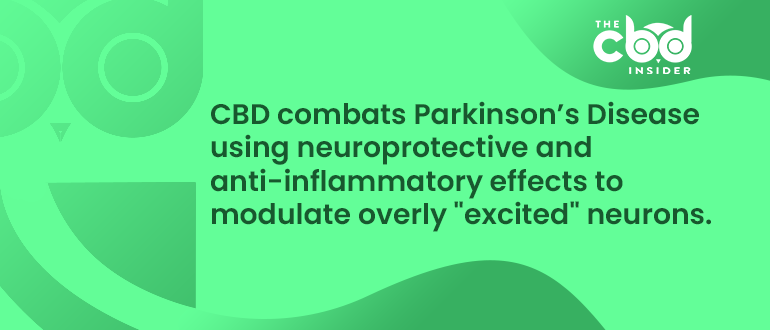
To even partially address the smattering of seemingly unrelated symptoms that PD patients have to deal with, potentially effective supplements like CBD must be multifaceted in their approach.
Indeed, CBD has been suggested by more than a few early findings to combat Parkinson’s Disease using neuroprotective and anti-inflammatory effects, modulating overly “excited” neurons, and working directly through the endocannabinoid signaling system.
CBD as an Anti-Inflammatory
With the exception of its anti-seizure capabilities, which are evident in the only FDA-approved CBD-based drug (Epidiolex), the anti-inflammatory capability of CBD is perhaps the most confidently documented benefit of this supplement to date.
Among other agents, our immune cells deploy proteins called cytokines that contribute greatly to the inflammation response.
CBD has been shown to suppress these proteins, which, in the case of the brain, are released by the overly excited microglia to cause neuroinflammation.
The relationship between CBD and inflammation is more nuanced than it seems, as CBD can actually have a pro-inflammatory role when it comes to specific cytokines and other inflammation factors.
However, in the case of microglial activation and PD-related neuroinflammation, researchers point to CBD’s potent anti-inflammatory effects as it modulates production and proliferation of cytokines like “tumor necrosis factor alpha,” another key player in inflammation.
CBD as an Antioxidant
Among its several functions, inflammation acts as a kind of “call-to-arms” for other immune cells.
After the cytokines have done their job, other immune cells rush to the inflamed area to attempt tissue repair in various ways.
Some of these immune cells release reactive oxygen species (ROS), which increases the ratio of free radicals to antioxidants in the body
This imbalance is the defining trait of oxidative stress, which leads to premature cell damage and death as well as, in a circular fashion, more inflammation.
We already have to contend with free radical production from other sources, including dietary and environmental influences, cellular processes like the breakdown of dopamine, and the natural aging process, which is why it’s wise to seek out antioxidant-rich foods and supplements.
CBD is one such supplement, as evidenced in this Complutense University of Madrid study involving PD-infected rats.
The researchers detected that CBD administration caused an “upregulation of mRNA levels for Cu,ZN-superoxide dismutase,” which is an enzyme that our bodies use to fight off oxidative damage and slow degeneration.
CBD can even neutralize reactive oxygen species, which are molecules that “steal” electrons from healthy neighbors and turn them into free radicals, by donating this electron without becoming reactive themselves.
CBD’s Potential as a Neuromodulator
We’ve mentioned several times how excitotoxicity, or the process by which nerve cells like the microglia become overstimulated, can be harmful because of the inflammation and cell damage that results from “too much help.”
Glutamate is the perfect example in the case of Parkinson’s Disease.
This powerful, excitatory neurotransmitter is what causes the microglia to go into overdrive in the first place.
Finding a substance that can flatten the spike of glutamate, then, will modulate neuroinflammation by preventing the microglia from overperforming in the first place.
This is where CBD may help, claims a study from the University Hospital of Puerta de Hierro in Madrid.
After dosing piglets who had hypoxic-ischemic brain injuries with CBD, researchers found that “CBD exerts robust neuroprotective effects … modulating excitotoxicity, oxidative stress and inflammation.”
The researchers believed that cannabidiol’s interactions with CB2 receptors as well as a serotonin receptor known as 5-HT1A were responsible for these benefits.
How CBD Can Slow PD Progression
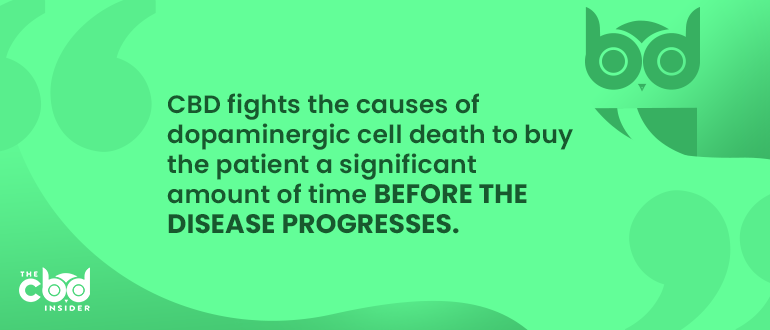
Neither CBD nor any medication or supplement to date can reverse or cure Parkinson’s symptomatology.
Researchers are hopeful, however, that CBD may slow the progression of the disease by facilitating dopamine recovery through CB2 stimulation, exerting antioxidant effects (also linked to CB2), suppressing the inflammatory response, and modulating excitotoxicity as mentioned.
In other words, CBD can’t re-synthesize what was lost, but it can fight the causes of dopaminergic cell death to buy the patient a potentially significant amount of time before the disease progresses.
Establishing a CBD routine before the onset of Parkinson’s may be an entirely different affair with more exciting implications, e.g., prevention, a prospect that has researchers investigating CBD’s many properties with renewed fervor.
Physicians often share the sentiment that prevention is the best cure, but the tricky element in this equation is taking the initiative before the problem arises, and not after.
In either case, before or after PD onset, cannabidiol may help people of all demographics improve their quality of life and overall health in more ways than one.


